Leaves are Shelter and So Much More!
Minimal Fall Cleanup and Protection for your Native Garden’s Aliveness
As Fall approaches we want to make sure our eco-functional garden is still serving the ecosystem. We have been taught to keep our gardens clean by tidying leaves, dead plant debris, and weeds out of the beds but this is actually harming the eco-functionality of our pollinator gardens. You can, however, edit plants that you don’t want in your beds. We are after all gardening.
Bare Late Blooms:
Our late blooming flowers like our asters give necessary food to our pollinators before they overwinter and produce seeds for birds to eat. Before weeding the garden, let Asters, Goldenrod (seen in pictures below) , and SnakeRoot serve their function and weed them only right before they go to seed if you really need to edit them out of your garden in fall.

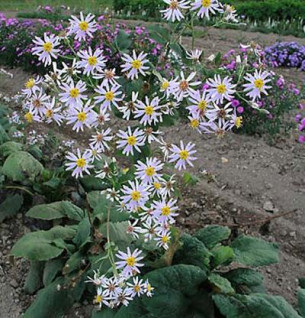
Leave the Leaves:
Shelter
Many insects (like native bees and fireflies) overwinter in fallen leaves that protect them from predation and weather conditions.This allows insects to go into dormancy. Small mammals like chipmunks and shrews burrow in leaf piles to escape the frigid temperatures. Similarly, frogs and turtles can take refuge in the leafy cover, allowing them a better chance at surviving winter.
Food
Fallen leaves also help to feed your soil and the vital microbes who compost these leaves giving your garden essential nutrients for next year’s growth. Additionally, many insects, including decomposers like earthworms, feed on the organic matter in leaves. These insects, in turn, serve as food for birds and other predators. Thus, the leaf litter serves as a vital link in the local food chain.
The Benefits to Birds
Leaf litter is not just beneficial for ground-dwelling animals; it’s a boon for our feathered friends as well. Birds such as robins and thrushes often forage in leaf litter, seeking insects and seeds. During the harsh winter months, when food is scarce, leaf litter becomes an essential foraging ground.
Important Note!
Raking, leaf blowing, and shedding your leaves can harm the delicate insects living in them! Make sure you wait until late Spring, when it is warm enough for insects to have already emerged, to do any plant debris removal.
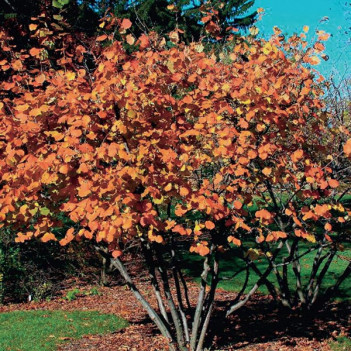
American Hazelnut's Fall foliage.
Allow Stems to Stand:
When plants go into dormancy, they pull all their energy down into their roots leaving behind dried plant material. This plant material is often overlooked, but serves a vital role in the ecosystem during the Fall. Some native bees use the leftover stems to hibernate during the Winter. Birds eat the dried seed in plants such as purple cone flowers, sunflowers, and Joe pye weed during the fall before hibernation. To keep your garden eco-functional, leave these plants to serve as food and protection for your local wildlife.
Examples of Insects Who Overwinter:
Black Swallowtail Butterflies (as seen in the photos below) overwinter in the Midwest rather than flying south like our Monarch Butterflies. Swallowtails will form a chrysalis that is often attached to a plant stem or tree. This allows them to endure the cold winter.
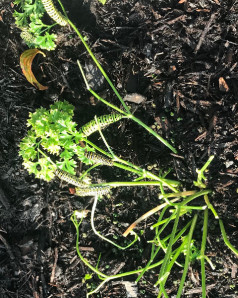
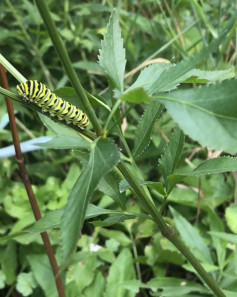
Other critters that overwinter in the Midwest include spiders, millipede, beetles, and snails. These animals are the base of the food chain and support birds, chipmunks, squirrels, and amphibians. It helps us sustain the natural cycle of life which is why it is so important to protect them during the Winter and Fall.
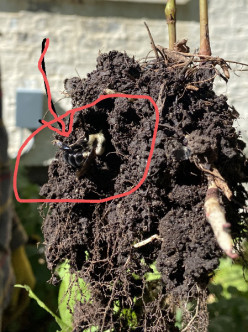
A happy queen bee snug in the soil ready for the cold winter.
Guard your Grasses:
Keeping your native grasses such Prairie Dropseed, Big Bluestem, and Switchgrass standing in the Fall provide habitat for native insects.
Protect your Plants:
Rabbit caging is important in the Fall. A popular food source for rabbits in winter are the barks of trees and shrubs. If you have witch hazels, small serviceberries, or newly planted apple or crabapple trees, you may want to protect them until they grow to a certain size where they can handle this winter abuse, rabbit caging is necessary to keep them alive and healthy. In addition, the rabbit population is higher than natural.
Plant Some More!
Native Shrubs and Trees: Plant species that are native to your area. They will not only adapt better to local soil and weather conditions but also provide familiar food and shelter to local wildlife.
Perennial Herbs and Flowers: Many herbs and flowering plants can be planted in the fall to bloom the following year.
Ephemeral Bulbs: Fall is the perfect time to plant bulbs which will provide early spring nectar sources for pollinators.
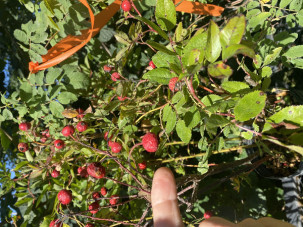
Photo at right shows rosehips from our native Rosa balanda (Pasture Rose) beloved food for many birds.
Takeaway: Think Twice, Rake Once!
So the next time you find yourself reaching for that rake or leaf blower, pause for a moment. Consider the bustling micro-ecosystem that you’d be disrupting, and think about the small creatures that could use those leaves as a winter home or meal. By letting the leaves lie, you’re doing your part to help local wildlife thrive.




